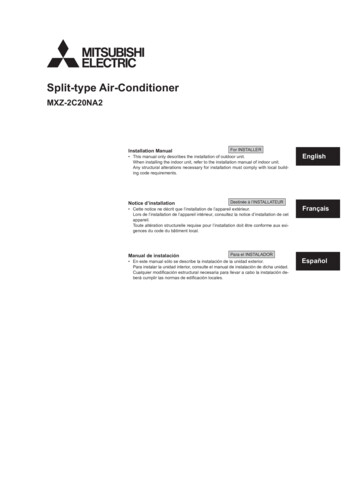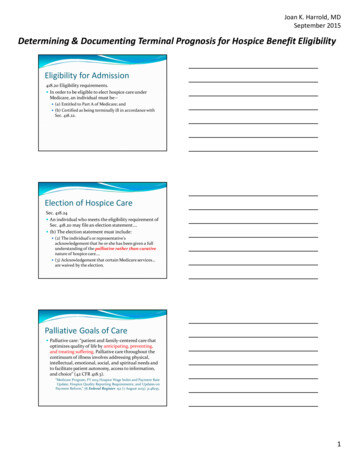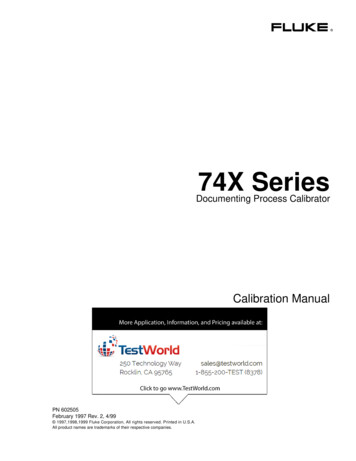
Transcription
Joan K. Harrold, MDSeptember 2015Determining & Documenting Terminal Prognosis for Hospice Benefit EligibilityEligibility for Admission418.20 Eligibility requirements.In order to be eligible to elect hospice care underMedicare, an individual must be-(a) Entitled to Part A of Medicare; and(b) Certified as being terminally ill in accordance withSec. 418.22.Election of Hospice CareSec. 418.24An individual who meets the eligibility requirement ofSec. 418.20 may file an election statement .(b) The election statement must include:(2) The individual's or representative'sacknowledgement that he or she has been given a fullunderstanding of the palliative rather than curativenature of hospice care .(3) Acknowledgement that certain Medicare services are waived by the election.Palliative Goals of CarePalliative care: “patient and family-centered care thatoptimizes quality of life by anticipating, preventing,and treating suffering. Palliative care throughout thecontinuum of illness involves addressing physical,intellectual, emotional, social, and spiritual needs andto facilitate patient autonomy, access to information,and choice” (42 CFR 418.3).“Medicare Program; FY 2014 Hospice Wage Index and Payment RateUpdate; Hospice Quality Reporting Requirements; and Updates onPayment Reform,” 78 Federal Register 152 (7 August 2013), p.48235.1
Joan K. Harrold, MDSeptember 2015Determining & Documenting Terminal Prognosis for Hospice Benefit EligibilityPalliative Goals of CareThe person beginning hospice care, or his or herrepresentative, needs to understand that his or herillness is no longer responding to medical interventionsto cure or slow the progression of disease and thenmust choose to stop further curative attempts whilepalliative care continues and intensifies, as needed, forcontinued symptom management. (Italics added)78 Federal Register 152 (7 August 2013), p.48235.Certification: Basis418.22 Certification of terminal illness.Based on the attending physician’s and medicaldirector’s clinical judgment.Must specify individual’s prognosis is for a lifeexpectancy of 6 months or less if the terminal illnessruns its normal courseClinical information / other documentation thatsupport the medical prognosis must accompany thecertification and be filed in the medical record withthe written certification.Initial verbally, then writtenWhat About the LCDs?Local Coverage DeterminationGuidelines for Determining PrognosisCancer, heart disease, lung disease, liver disease, lungdisease, renal failure, stroke and coma, HIV, ALS,Alzheimer’s and related disorders,NOT exclusionaryNOT comprehensiveNOT definitive2
Joan K. Harrold, MDSeptember 2015Determining & Documenting Terminal Prognosis for Hospice Benefit EligibilityLCDs—NOT ExclusionaryPatients who meet the guidelines established hereinare expected to have a life expectancy of six months orless if the terminal illness runs its normal course.Some patients may not meet these guidelines, yet stillhave a life expectancy of 6 months or less. Coverage forthese patients may be approved if documentation ofclinical factors supporting a less than 6-month lifeexpectancy not included in these guidelines isprovided.Prognosis: Heart DiseaseRecent cardiac hospitalization, co-morbiditiesLV ejection fraction 45%Functional status, cachexiaSBP 100 mm Hg and/or pulse 100 bpmLabs: anemia, hyponatremia, elevated BUN, Creatinine 1.4mg/dlVentricular dysrhythmias (treatment resistant)Seattle Heart Failure pt 1&enter Enter72Prognosis: Lung DiseaseAmbulatory patientsFEV 1, age, exercise capacity, low BMI, low PaO2, patientassessment of dyspneaHospitalized patientsAge, functional status, co morbidities, severity of illness(APACHE II), need for mechanical ventilation, hypoxia,hypercarbia, low serum albumin, low hemoglobin733
Joan K. Harrold, MDSeptember 2015Determining & Documenting Terminal Prognosis for Hospice Benefit EligibilityPrognosis: Renal DiseaseAgeFunctional statusCo morbiditiesAlbumin 3.5 g/dLCreatinine clearanceRefusal or discontinuation of dialysis74Prognosis: Liver DiseaseAgeCo-morbiditiesHepatorenal syndromeHepatocellular carcinomaAscitesEncephalopathyLabs: bilirubin, albumin, prolonged PTTRate of clinical decompensationMELD Score sp75Prognosis: CancerCancerPoor functional statusKarnofsky 50, ECOG 3http://www.ecog.org/general/perf stat.htmlMalignant effusionsPericardial, pleural, ascitesMultiple brain metastases or carcinomatous meningitisMalignant bowel obstructionSerum albumin 2.5 mg/dlHypercalcemiaexcept in newly diagnosed breast cancer or myeloma694
Joan K. Harrold, MDSeptember 2015Determining & Documenting Terminal Prognosis for Hospice Benefit EligibilityPrognosis: CancerCancers with Prognosis 6 MonthsMetastatic lung cancerUnresectable pancreatic cancerProgressive metastatic breast or prostate cancer withpoor or decreasing functional statusMetastatic solid tumor, acute leukemia, or high-gradelymphoma forgoing chemotherapy70Prognosis: CancerSalpeter SR, Malter DS, Luo EJ, Lin AY, Stuart B.Systematic review of cancer presentations with amedian survival of six months or less. J PalliatMed. 2012 Feb;15(2):175-85.To report cancer presentations with a median survival of6 months or less and the effect of treatment on survival.Despite different cancer characteristics, found “a fairlyuniversal picture of terminal disease.”Prognosis: CancerCharacteristicsDecreasing performance statusAdvancing ageWeight lossMetastatic diseaseDisease recurrenceLab abnormalities indicating extensive diseaseLittle evidence that treatment improved survivalIncreased risk for toxicity.5
Joan K. Harrold, MDSeptember 2015Determining & Documenting Terminal Prognosis for Hospice Benefit EligibilityLCDs—NOT ComprehensiveNot the only diagnoses that can—or should be—usedto enroll patients in hospice careLook up diagnoses in the coding manual!LCDs—NOT DefinitiveSupport a prognosis consistent with eligibility whenthat prognosis continues to be reasonableMAC: pts with AFTT expected to have BMI 22 and aKPS or PPS 40NHLBI BMI: normal weight 18.5–24.9PPS 40 mainly in bed and mainly needing assistancewith self-careDid that mean that every pt with BMI 20 and PPS 40 iseligible for the Medicare Hospice Benefit—forever?LCDs: Co-morbiditiesThe presence of diseases, the severity of which is likely tocontribute to a life expectancy of six months or less,should be considered in determining hospice eligibility.Chronic obstructive pulmonarydiseaseCongestive heart failureIschemic heart diseaseDiabetes mellitusNeurologic disease (CVA, ALS,MS, Parkinson’s)Renal failureLiver DiseaseNeoplasiaAcquired immune deficiencysyndromeDementia6
Joan K. Harrold, MDSeptember 2015Determining & Documenting Terminal Prognosis for Hospice Benefit EligibilityGeneral GuidelinesThe amount and detail of documentation will differ indifferent situations. Thus a patient with metastaticsmall cell CA may be demonstrated to be hospiceeligible with less documentation than a chronic lungdisease patient.Patients with chronic diseases, long term survival inhospice, or apparent stability can still be eligible forhospice benefits, but sufficient justification for a lessthan six month prognosis should appear in the record.General GuidelinesIf the documentation includes findings inconsistentwith/tending to disprove a 6-month prognosis, theyshould be addressed, refuted, and/or explained.Many observations suggestive of a greater than 6 monthprognosis are predictable and apparent, such as aprolonged stay in hospice or a low immediate mortalitydiagnosis.Specific findings may also call for an answer, such asrecovery of ADLs when they were part of the basis forthe initial eligibility.General GuidelinesRecurrent or intractable infectionsPneumonia URIUpper urinary tract pyelo simple UTISymptoms of pyelonephritis can vary depending on aperson’s age and may include the following:Fever, chills, nausea, vomitingBack, side, and groin painFrequent, painful urinationOlder people may not have any symptoms related to theurinary tract either; instead, they may exhibit confusion,disordered speech, or hallucinations.7
Joan K. Harrold, MDSeptember 2015Determining & Documenting Terminal Prognosis for Hospice Benefit EligibilityGeneral GuidelinesProgressive inanitionIrreversible weight lossIrreversible and decreasing anthropomorphicmeasurements (MAC, abdominal girth)Decreasing serum albumin or cholesterolDysphagia leading to recurrent aspiration and/orinadequate oral intake (documented decreasing foodconsumption)Palmetto GBA on weight lossPalmetto GBA expects to see supportingdocumentation of the absolute weights used tocalculate the percent decrease. The reporting ofabsolute weights strengthens documentation ofpercent change in weight over time (e.g., 10% weightloss over the last six months with weight decreasingfrom 110 pounds to 95 pounds).Unsupported percent weight loss in the medical recordmay result in a denial if other documentation does notlend support to impaired nutritional status.Palliative Performance ScorePPS scores are determined by reading horizontally ateach level to find a ‘best fit’ for the patient which isthen assigned as the PPS% score.‘Leftward’ columns are ‘stronger’ determinants andgenerally take precedence over others.If several columns are easily placed at one level, make a‘best fit’ decision. Choosing a ‘half-fit’ value of PPS (ex:45%) is not correct.http://palliative.info/resource material/PPSv2.pdf8
Joan K. Harrold, MDSeptember 2015Determining & Documenting Terminal Prognosis for Hospice Benefit EligibilityFunctional Assessment StagingFAST for Dementia (not other conditions)Speech: capability, not content7A ability to speak limited to approximately a halfdozen different words or fewer, in the course of anaverage day or in the course of an intensive interview7B speech ability limited to the use of a singleintelligible word in an average day or in the course ofan interview (the person may repeat the word over andover)Functional Assessment StagingAmbulation and posture: impaired due to dementia7C ambulatory ability lost (cannot walk withoutpersonal assistance).7D ability to sit up without assistance lost (e.g., theindividual will fall over if there are no lateral rests[arms] on the chair).Mortality Risk Index (Score)Estimate of 6 month px in NH residents with advanced dementiaComposite score: 12 risk factors derived from MDSValidated: 11,000 newly admitted residents with advanceddementiaTotal Risk Score is % Estimate of Death Within6 Months08.91 or 210.83, 4, or 523.26, 7, or 840.49, 10, or 1157.0 1270.09
Joan K. Harrold, MDSeptember 2015Determining & Documenting Terminal Prognosis for Hospice Benefit EligibilityMortality Risk Index (Score)Cut score of 959.7% would die within 6 months of admission (PPV)Only 28.7% of residents with advanced dementia whodied within that period would be eligible (sensitivity).Cut score of 6Only 46.6% of enrollees would die within 6 months72.8% of residents with advanced dementia who diedwithin that period would be eligible for hospice care.ADEPTEstimate of 6 month px in NH residents with advanceddementiaComposite score: 12 risk factors derived from MDSRecent NH admission, age, male, shortness of breath,pressure ulcers, ADL score, bedfast, insufficient oralintake, bowel incontinence, BMI 18.5 kg/m2, weightloss, and congestive heart failure.Validated: 218,000 NH residents with advanced dementiaPossible total score and the 6- and 12-month probabilitiesof death with each total scoreFunctional StatusAddress the patient’s functional status with anappropriate scaleGive a historical perspective of what the patient’sability was in the previous time period and thendocument current statusBUT REMEMBER Decline eligibilityDecline necessary or sufficient10
Joan K. Harrold, MDSeptember 2015Determining & Documenting Terminal Prognosis for Hospice Benefit Eligibility418.25 Admission to hospiceThe hospice admits a patient only on therecommendation of the medical director inconsultation with, or with input from, the patient’sattending physician (if any).In reaching a decision to certify that the patient isterminally ill, the hospice medical director must considerat least the following information:(1) Diagnosis of the terminal condition of the patient.(2) Other health conditions, whether related or unrelated tothe terminal condition.(3) Current clinically relevant information supporting alldiagnoses.Determining the Principal DxThe principal diagnosis should reflect the conditionto be chiefly responsible for the services provided.The principal diagnosis reported on the hospiceclaim form should be determined by the hospice asthe diagnosis most contributory to the terminalprognosis.It is often not a single diagnosis that represents theterminal prognosis of the patient, but the combinedeffect of several conditions that makes the patient’scondition terminal.78 Federal Register 152 (7 August 2013), pp.48236, 48242.Determining the Principal DxThe principal diagnosis should be the conditiondetermined by the certifying hospice physician(s) asthe diagnosis most contributory to the terminaldecline.Certifying physicians should use their best clinicaljudgment in determining the principal diagnosis andrelated conditions, based on the hospicecomprehensive assessment and review of any and allother clinical documentation.78 Federal Register 152 (7 August 2013), p.48240, 48243.11
Joan K. Harrold, MDSeptember 2015Determining & Documenting Terminal Prognosis for Hospice Benefit EligibilityMost Contributory DxLCDs: not the only diagnoses that can—or shouldbe—used to enroll patients in hospice careLook up diagnoses in the coding manual!This may be difficult for some providers to accept asthey may not understand how malnutrition, anemia, ordepression, for example, could be reported as aprincipal hospice diagnosis.78 Federal Register 152 (7 August 2013), pp.48248-9.Determining the Terminal Dx unable to determine the principal terminaldiagnosis did not meet criteria for being terminally illper LCDs.We are clarifying that in a scenario such as this, thecertifying physician would select the condition he or shefeels is most contributory to the terminal prognosis.We are clarifying that this principal diagnosis, along withthe other related diagnoses, would be included on thehospice claim.78 Federal Register 152 (7 August 2013), p.48247.Determining the Terminal DxWe are stating that all diagnoses contributing to (that is,related to) the terminal prognosis of the individual are to bereported on the hospice claims in order to account for theindividual needs of each and every Medicare hospicebeneficiary.Having all related conditions reported on the hospice claimform, and not just a single diagnosis, such as ill-defined,symptom diagnosis, will ensure that hospices are aware of andprovide all of the expert care, including services, drugs,supplies, and DME, that a Medicare hospice beneficiaryrequires as he or she approaches end-of-life.78 Federal Register 152 (7 August 2013), p.48248.12
Joan K. Harrold, MDSeptember 2015Determining & Documenting Terminal Prognosis for Hospice Benefit EligibilityDetermining the Terminal DxMalnutrition, dysphagia, and decreased functionalstatus and muscle weakness. . There are ICD-9-CMcodes for all of the clinical presentations listed above. eligibility should always have been based on theterminal prognosis of the patient, and this prognosiswould typically involve more than one diagnosis.78 Federal Register 152 (7 August 2013), p.48248-9.Certification: 6 Month PrognosisBased on the physician’s or medical director’s clinicaljudgment regarding the normal course of the individual’sillnessSpecify that the individual’s prognosis is for a lifeexpectancy of 6 months or less if the terminal illness runsits normal courseClinical information and other documentation that supportthe medical prognosisMust accompany the certification and be filed in the recordMay be provided verballyMust be documented in the recordIs included as part of the eligibility assessmentOrganizational processes. . . to confidently support Deliberationand, of course Education!13
Joan K. Harrold, MDSeptember 2015Determining & Documenting Terminal Prognosis for Hospice Benefit EligibilityInformationClinical summariesChecking boxes on forms is NOT enoughPatient’s storyDiagnostic tests, dates, resultsAdditional medical recordsHospital, physician, NHCopies and quotesInformationAvoid the “sterility” of the EMRGeneral appearanceSubjective statementsAbout how they are, not “random” or social commentsSOAP (subjective) is NOT:“Can someone mow my yard this week?”And SOAP (objective) is NOT just:“Pt lying in recliner with eyes shut and a cat on his lap.”Physical assessment/observations should be relevantto the diagnosis and prognosisInformationExpand on checklists and pic lists for physicalassessmentNote changes from previous visits (more/less)Functional status ability, not activityIndependent or only doing what can be doneindependently?Course of care/Status/Recert summariesCheck against clinical documentationInclude dates and values for measuresWts, MAC, ambulatory ability, etc.Summarize and explain14
Joan K. Harrold, MDSeptember 2015Determining & Documenting Terminal Prognosis for Hospice Benefit EligibilityCollaborationCertification medical decision with IDT inputPOC interdisciplinary decision with medical inputDocumentation everybody’s inputAnd the notes from different disciplines must beconsistent and support one another—or explain whythey don’tEducationElection choosing hospice careUsing the toolsLCDs, functional scales, disease-specific characteristicsClinical summaries—what to include, how to writeOngoing documentationDisease-specific and general symptomsObservations to recordPeriodic summaries that go beyond checkboxesEducationPhysicians and narrativesReason and purpose of the narrativePrognostic content of the narrativeExplanation of data that is unexpectedTraining, tools, and forms that encourage goodnarratives15
Joan K. Harrold, MDSeptember 2015Determining & Documenting Terminal Prognosis for Hospice Benefit EligibilityPhysician Narrative: RegulationEffective October 1, 2009The physician must compose a brief narrativeexplanation that supports a life expectancy of sixmonths or less as part of certification andrecertificationWritten by EITHER the attending or hospice medicaldirectorPart of the certification form orAttached as an addendumThe narrative is documentation unique to physicians.a GIFT to be used wisely and wellPhysician Narrative: RegulationMust reflect the patient’s individual clinicalcircumstancesMust NOT contain check boxes or standard languageused for all patientsMust include the clinical findings of required FTFsInterdisciplinary teamVisit and summary documentation MUST support thenarrative.Physician Narrative: RegulationThe narrative must be composed by the physicianperforming the certification or recertification—NOTby other hospice personnel.The narrative should include a statement that thephysician confirms that the narrative is based onreview of the patient’s medical record, or if applicable,examination of the patient.3716
Joan K. Harrold, MDSeptember 2015Determining & Documenting Terminal Prognosis for Hospice Benefit EligibilityPhysician Narrative: RationaleEnsure that only eligible patients are certified.Have the physician justify prognosis, not merely sign aform.Encourage greater physician engagement in thecertification process by highlighting the physician’sresponsibility articulate the clinical basis for theterminal prognosis.Physician Narrative: ProcessDistill the available clinical information into a succinctform that supports eligibility.Ensure that the narrative follows logically from theinformation that is documented from IDT visits anddiscussionsInclude and/or interpret the information from theFace to Face documentationPhysician Narrative: ProductThe physician’s summary of what should already bedocumentedShould rarely contain new informationMay interpret information in a newly documented wayFocuses on factors of prognostic importanceSynthesizes the patient’s comprehensive medicalinformation in order to justify admissionto/continuation of payment for hospice services17
Joan K. Harrold, MDSeptember 2015Determining & Documenting Terminal Prognosis for Hospice Benefit EligibilityPhysician CertificationREMEMBERAll certifications and re-certifications must be signedand dated by the physicianThey must also include the benefit period dates towhich the certification or recertification applies.Recertifications: IDT MeetingsPatients are discussed every 2 weeks in the IDTmeetingEligibility and re-certifications should be discussed asa matter of routineAsk in advance if there are any concerns aboutupcoming recertificationsNo recertification decision should be surprise or anemergency. We have the entire benefit period to gatherdata, make clinical decisions, and determine eligibility.(Re)certification: Then and NowTHENWould we admit if we saw this person today?NOWKnowing what we now know about this patient (aftermonths of care), why do we still think she has aprognosis of 6 months or less?18
Joan K. Harrold, MDSeptember 2015Determining & Documenting Terminal Prognosis for Hospice Benefit EligibilityPhysician Narrative: A Case84 year old with advanced dementia, wt loss, decline,pneumonia. Pt appropriate.Is he?Physician Narrative: A84 year old with Alzheimer’s dementiaRenal insufficiency, irritable bowel syndromePneumonia and delirium with hospitalization a yearagoWeighs 190 lbs with 10 lb loss in the last 6 monthsBedboundIntermittently holds food and medications in hismouthPhysician Narrative: B84 year old with Alzheimer’s dementiaRenal insufficiency, irritable bowel syndromePneumonia and delirium with hospitalization twomonths agoWeighs 120 lbs with 30 lb loss in the last 6 monthsBedboundHolds food and medications in his mouthDiet changed due to choking episodes19
Joan K. Harrold, MDSeptember 2015Determining & Documenting Terminal Prognosis for Hospice Benefit EligibilityThe Good Based on advanced Alzheimer’s disease, recent aspirationpneumonia, persistent dysphagia and aspiration risk, and20% wt loss in past 6 months, pt is certified.Focuses on prognostic factors. the Bad 84 year old with advanced dementia, wt loss, decline,pneumonia. Pt appropriate.Timing of wt loss not clearDecline not clearPneumonia not recent and the UglyPt died.Insufficient justification of hospice eligibility onadmission20
Joan K. Harrold, MDSeptember 2015Determining & Documenting Terminal Prognosis for Hospice Benefit EligibilityOther Uses of the NarrativeFindings inconsistent with less than 6-monthprognosis, should be answered or refuted by otherentries, or specifically addressed and explained.Patient doesn’t meet LCDs but is eligibleDementia, FAST 6, losing weightMost facts and observations tending to suggest agreater than 6 month prognosis are predictable andapparentA prolonged stay in hospiceLow immediate mortality diagnosisOther Uses of the NarrativeSpecific entries can also call for an answerAn opinion by one team memberRecovery of ADLs when they were part of the basis forthe initial declaration of eligibilityLack of certain documentation elements may alsonecessitate other supportive documentationNo tissue diagnosis for a hospice diagnosis of cancerComponents of a Narrative . . .AgePrinciple diagnosisSecondary diagnoses that contribute to the prognosisof 6 months or less21
Joan K. Harrold, MDSeptember 2015Determining & Documenting Terminal Prognosis for Hospice Benefit EligibilityComponents of a Narrative . . .Clinical factors that support/associated with a prognosis of6 months or lessHistoryRelevant hospitalizations and/or ED visitsDisease progression and trajectory of declineSymptomsSigns noted on nursing assessmentLab and/or XR dataOther LCDs factorsPublished dataIndividual clinical circumstances. . . Components of a NarrativePPS, ECOG, FAST, other functional assessmentDesire for hospice support for palliative goals of careInterpretation of factors typically associated with aprognosis longer than 6 monthsReferences (yes, in the narrative)Salpeter et al. J Palliat Med. 2012 Feb;15(2):175-85.Patient is a 91 year old female with primary diagnosis of aortic stenosis.Past medical history significant for hypothyroidism and hypertension.She has had a previous MI in the past. She had been living at LovingPersonal Care. 1 week ago she had increased confusion, was walkingnaked in the halls, and staff was unable to obtain a urinalysis. She wastaken to AGH and treated for a UTI. While she was there it was foundthat she was in atrial fibrillation and her sodium was decreased. LastECHO with 25-30% EF. She was discharged 2 days ago to LNH. Shebecame unresponsive at LNH and was not able to move her arms at all.They were not able to obtain a pulse ox and after applying oxygen, herpulse ox was very low. She was transferred to AGH where the physicianbelieves she was having a silent MI. She is now in CHF and has beendiuresed. Her family has decided on comfort care measures. She isminimally responsive, able to open her eyes for short periods, with nopurposeful movement. She is oxygen dependent. She is receiving10mg CLM every one hour for pain and dyspnea. She has short 15-20second periods of apnea, and her color is noted to be gray. She is aDNR.22
Joan K. Harrold, MDSeptember 2015Determining & Documenting Terminal Prognosis for Hospice Benefit Eligibility91 year old with aortic stenosis is certified with EF 2530%, apparent MI heralded by syncope and hypoxia,CHF requiring diuresis, minimal responsiveness, 15-20sec apnea, PPS 10, and palliative goals of care.GIP Level of CareAcute care which cannot be provided in anothersetting:Management of active symptomsPain control or symptom management, includingfamily education, following hospitalization while thepatient prepares to receive home hospice careMonitoring effectiveness and/or complicationsfollowing medication adjustment or other recentinterventions, including those performed in hospitalGIP Level of Care (cont.)Skilled interventions, including, but not limited to,care of extensive wounds, frequent medicationadministration, monitoring and/or management offluctuating and distressing symptoms that cannot bemanaged in the home settingCare of a patient whose family is unwilling to permitneeded care to be furnished in the home23
Joan K. Harrold, MDSeptember 2015Determining & Documenting Terminal Prognosis for Hospice Benefit EligibilityDocumentation to support GIPChart should include the precipitating event as well aswhat interventions were tried prior to the initiation ofGIP.For patients who are being monitored following medchanges but no longer having obvious sx, MUSTDOCUMENT approximately how long you expect tomonitor for med effectiveness.Changes are not made until AFTER orders are writtenand new doses may not be given until much later.Documentation to support GIPOpioids increased last night. Will need to monitor forpain and use of BT meds for approx. 48 hours to see ifnew dose effectively and reliably controls pain so pt canreturn home.Remember to document conversation with pt/family:“If the medications are working well to manage yourpain, then we’ll plan for you to go home the day aftertomorrow. If not, we’ll make a new plan.”Supports the plan, models language, and shows DCplanningDocumentation to support GIPFor actively dying patients without obvioussx: document that pt is actively dying, cannot bemoved, and what is being monitored. Not just “ptlooks comfortable” or “no symptoms” or “symptomsmanaged”. Need to focus on what we are still doing,not that it worked.Pt actively dying with no intake, minimalresponsiveness, and inability to report pain or distress.Pt is critically ill and unstable for transfer. Willcontinue to monitor for pain, respiratory distress,delirium, and/or other sx that pt cannot self-report.24
Joan K. Harrold, MDSeptember 2015Determining & Documenting Terminal Prognosis for Hospice Benefit EligibilityReferences“Medicare Program; FY 2014 Hospice Wage Index andPayment Rate Update; Hospice Quality ReportingRequirements; and Updates on Payment Reform,” 78Federal Register 152 (7 August 2013), pp.48234-48281.Salpeter SR, Malter DS, Luo EJ, Lin AY, Stuart B.Systematic review of cancer presentations with amedian survival of six months or less. J Palliat Med.2012 Feb;15(2):175-85.ReferencesPalliative Performance Scale (PPSv2) version 2 athttp://palliative.info/resource material/PPSv2.pdfPrognostication in Dementia, Fast Facts & ndex/ff 150.htmFunctional Assessment Staging Test,http://www.mciscreen.com/pdf/fast overview.pdfMitchell S, Kiely D, Hamel MB, et al. EstimatingPrognosis for Nursing Home Residents WithAdvanced Dementia. JAMA. 2004;291:2734-2740.ReferencesMitchell S, Miller S, Teno J, et al. The AdvancedDementia Prognostic Tool (ADEPT): A Risk Score toEstimate Survival in Nursing Home Residents withAdvanced Dementia. J Pain Symp Manage. 2010November; 40(5): 639–651.Mitchell S, Miller S, Teno J, et al. Prediction of 6Month Survival of Nursing Home Residents WithAdvanced Dementia Using ADEPT vs HospiceEligibility Guidelines. JAMA. 2010 November 3;304(17): 1929–1935.25
Palmetto GBA on weight loss Palmetto GBA expects to see supporting documentation of the absolute weights used to calculate the percent decrease. The reporting of absolute weights strengthens documentation of percent change in weight over time (e.g., 10% weight loss over the last six months with










